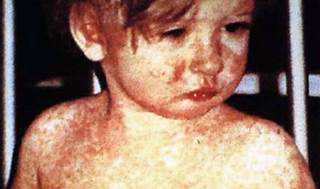A client is concerned about the contagiousness of measles. What information provided by the nurse is accurate regarding the period of contagiousness?
The client is contagious from the onset of the rash until two days afterward.
The client is contagious for about a week after the rash appears.
The client is only contagious before the appearance of the rash.
The client is no longer contagious after the fever subsides.
The Correct Answer is B
Choice B rationale:
The nurse accurately informs the client that they are contagious for about a week after the rash appears. The period of contagiousness starts a few days before the rash appears and continues until approximately 4 days after the rash has emerged. Measles is highly contagious, and transmission occurs through respiratory droplets from coughing or sneezing.
Choice A rationale:
This statement is incorrect. The client is contagious a few days before the rash appears and not only from the onset of the rash until two days afterward.
Choice C rationale:
This statement is incorrect. The client is contagious during the prodrome stage, which is before the appearance of the rash, as well as during the exanthematous stage when the rash is present.
Choice D rationale:
This statement is incorrect. The fever subsides during the prodrome stage, but the client remains contagious during the early part of the exanthematous stage when the rash is present.
Nursing Test Bank
Naxlex Comprehensive Predictor Exams
Related Questions
Correct Answer is D
Explanation

The correct answer is choice d. Airborne precautions.
Choice A rationale:
Standard precautions are the basic level of infection control that should be used in the care of all patients all of the time. These precautions are designed to reduce the risk of transmission of microorganisms from both recognized and unrecognized sources. However, they are not sufficient to prevent the transmission of measles, which is an airborne virus.
Choice B rationale:
Droplet precautions are used for diseases that are transmitted by large droplets that are expelled into the air and travel 3 to 6 feet from the patient. Measles is not primarily transmitted by large droplets and therefore, droplet precautions are not the most effective measure for preventing measles transmission.
Choice C rationale:
Contact precautions are used for infections, diseases, or germs that are spread by touching the patient or items in the patient’s room. Measles is highly contagious and can be spread through the air by breathing, coughing, or sneezing, so contact precautions alone would not prevent the spread of measles.
Choice D rationale:
Airborne precautions are required for diseases that are transmitted by smaller droplets, which remain in the air for long periods of time and can be spread over long distances when the infected person breathes, coughs, or sneezes. Measles is known to be highly contagious and can remain airborne for up to two hours in an airspace after the infected person leaves an area. Therefore, airborne precautions, which include the use of a high-efficiency particulate air (HEPA) filter and special respiratory protection, are necessary to prevent the spread of measles.
Correct Answer is C
Explanation
Choice A rationale:
Encouraging the client to avoid exposure to sunlight is not a preventive measure for measles. Measles is a viral infection transmitted through respiratory droplets, not sunlight exposure. Sunlight exposure is important for the synthesis of vitamin D and has no direct relation to measles prevention.
Choice B rationale:
Advising the client to avoid contact with people who have a common cold is not a preventive measure for measles. While respiratory infections might have similar symptoms to measles, the viruses causing them are different, and avoiding people with a common cold would not protect against measles.
Choice C rationale:
Suggesting the client receive the live attenuated measles vaccine as part of the MMR combination is the correct preventive measure for measles. The MMR vaccine contains live but weakened forms of measles, mumps, and rubella viruses. It provides immunity against these diseases and is highly effective in preventing measles infection.
Choice D rationale:
Recommending taking antibiotics prophylactically is not appropriate for measles prevention. Measles is a viral infection, and antibiotics are only effective against bacterial infections, not viral ones. Prophylactic use of antibiotics can lead to antibiotic resistance and is not indicated for preventing measles.
Whether you are a student looking to ace your exams or a practicing nurse seeking to enhance your expertise , our nursing education contents will empower you with the confidence and competence to make a difference in the lives of patients and become a respected leader in the healthcare field.
Visit Naxlex, invest in your future and unlock endless possibilities with our unparalleled nursing education contents today
Report Wrong Answer on the Current Question
Do you disagree with the answer? If yes, what is your expected answer? Explain.
Kindly be descriptive with the issue you are facing.
